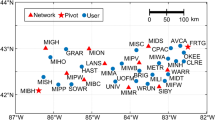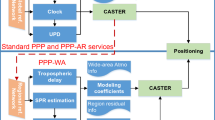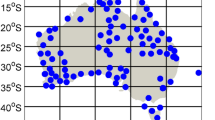Abstract
We extend the current Undifferenced network RTK (URTK) approaches by additionally using P1/CA augmentation information from reference stations. P1/CA augmentation information can shorten the convergence time and help to fix the ionosphere-free combination ambiguities in several epochs. Instantaneous and centimeter-level positioning solutions can be achieved for rovers within the coverage of regional reference network. Also, we develop an approach for seamless transition between URTK and precise point positioning with ambiguity resolution (PPP-AR) and present a new scheme to provide URTK service. Therefore, a service for a large number of rovers can be easily realized in real-time data communication for ambiguity fixing. In addition, the period when augmentation information from a particular reference station is not available can be bridged with the help of PPP-AR. Rovers can experience more operational time with fewer interruptions, which are difficult tasks for current URTK and Network Real-Time Kinematic services. More importantly, with this new scheme, URTK and PPP-AR services can be integrated into a unique PPP-AR system. The obtained convergence time only depends on whether or not the rover is receiving the regional augmentation information.




Similar content being viewed by others
References
Collins P, Bisnath S, Lahaye F, Heroux P (2010) Undifferenced GPS ambiguity resolution using the decoupled clock model and ambiguity datum fixing. Navigation 57(2):123–135
Euler HJ, Schaffrin B (1991) On a measure of the discernibility between different ambiguity solutions in the static-kinematic GPS mode. In: Schwarz KP, Lachapelle G (eds) Kinematic Systems in Geodesy, Surveying and Remote Sensing, IAG Symposium No. 107. Springer-Verlag, New York, pp 285–295
Gabor MJ, Nerem RS (1999) GPS carrier phase AR using satellite-satellite single difference. Proc ION-GPS-1999, Institute of Navigation, Nashville, USA, pp 1569–1578
Gao Y, Li Z, McLellan JF (1997) Carrier phase based regional area differential GPS for decimeter-level positioning and navigation. Proc ION-GPS-1997, Institute of Navigation, Kansas, USA, pp 1305–1313
Ge M, Gendt G, Rothacher M, Shi C, Liu J (2008) Resolution of GPS carrier-phase ambiguities in precise point positioning (PPP) with daily observations. J Geod 82(7):389–399
Ge M, Zou X, Dick G, Jiang W, Wickert J, Liu J (2010) An alternative Network RTK approach based on undifferenced observation corrections. Proc ION-GNSS-2010, Porland, USA, Oral report
Ge M, Chen J, Dousa J, Gendt G, Wickert J (2012) A computationally efficient approach for estimating high-rate satellite clock corrections in realtime. GPS Solut 16:9–15
Geng J, Teferle FN, Meng X, Dodson AH (2011) Towards PPP-RTK: ambiguity resolution in real-time precise point positioning. Adv Space Res 47(10):1664–1673
Geng J, Shi C, Ge M, Dodson AH, Lou Y, Zhao Q, Liu J (2012) Improving the estimation of fractional-cycle biases for ambiguity resolution in precise point positioning. J Geod 86(8):579–589
Hatch Ron (1982) The Synergism of GPS Code and Carrier Measurements. In: Proceedings of the Third International Symposium on Satellite Doppler Positioning at Physical Sciences Laboratory of New Mexico State University, Feb. 8–12, vol 2, pp 1213–1231
Hauschild A, Montenbruck O (2009) Kalman-filter-based GPS clock estimation for near realtime positioning. GPS Solut 13(3):173–182. doi:10.1007/s10291-008-0110-3
Li X, Zhang X, Ge M (2011) Regional reference network augmented precise point positioning for instantaneous ambiguity resolution. J Geod 85(3):151–158
Li X, Ge M, Zhang H, Wickert J (2013) A method for improving uncalibrated phase delay estimation and ambiguity-fixing in real-time precise point positioning. J Geod 87(5):405–416. doi:10.1007/s00190-013-0611-x
Melbourne WG (1985) The case for ranging in GPS-based geodetic systems. In: Proceedings of first international symposium on precise positioning with the global positioning system, Rockville, US, pp 373–386
Petit G, Luzum B (2010). IERS Conventions 2010. Verlag des Bundesamts für Kartographie und Geodäsie, 2010. pp 179, ISBN: 3-89888-989-6
Raquet J, Lachapelle G, Fortes L (1998) Use of a covariance analysis technique for predicting performance of regional area differential code and carrier-phase networks. Navigation 48(1):25–34
Schmid R, Steigenberger P, Gendt G, Ge M, Rothacher M (2007) Generation of a consistent absolute phase-center correction model for GPS receiver and satellite antennas. J Geod 81(12):781–798
Shi C, Zhao Q, Geng J, Lou Y, Ge M, Liu J (2008) Recent development of PANDA software in GNSS data processing, ICEODPA 2008 Proc. of SPIE vol 7285 72851S
Teunissen PJG (1995) The least-squares ambiguity decorrelation adjustment: a method for fast GPS integer ambiguity estimation. J Geod 70(1–2):65–82
Teunissen PJG, Odijk D, Zhang B (2010) PPP-RTK: results of CORS network-based PPP with integer ambiguity resolution. Journal of Aeronautics, Astronaut Aviat Ser A 42(4):223–230
Wu JT, Wu SC, Hajj GA, Bertiger WI, Lichten SM (1993) Effects of antenna orientation on GPS carrier phase. Manuscr Geod 18(2):91–98
Wübbena G (1985) Software developments for geodetic positioning with GPS using TI-4100 code and carrier measurements. In: Proceedings of first international symposium on precise positioning with the global positioning system, Rockville, US, pp 403–412
Zhang X, Li X, Guo F (2011) Satellite clock estimation at 1 Hz for realtime kinematic PPP applications. GPS Solut 15(4):315–324. doi:10.1007/s10291-010-0191-7
Zou X, Ge M, Tang W, Shi C, Liu J (2012) URTK: undifferenced Network RTK positioning. GPS Solut 17:283–293. doi:10.1007/s10291-012-0277-5
Zumberge J, Heflin M, Jefferson D, Watkins M, Webb F (1997) Precise point positioning for the efficient and robust analysis of GPS data from large networks. J Geophys Res 102(B3):5005–5017
Acknowledgments
This work is supported by the National Natural Science Foundation of China (Grant Nos. 41304028 and 41004003), the Open Foundation of the State Key Laboratory of Geodesy and Earth’s Dynamics (Grant No. SKLGED2013-4-9-E), Specialized Research Fund for the Doctoral Program of Higher Education (SRFDP) (Grant No. 20130141120005), China 863 program (Grant Nos. 2012AA12A202 and 2014AA123101) and the 111 project (Grant No. B07037).
Author information
Authors and Affiliations
Corresponding author
Rights and permissions
About this article
Cite this article
Zou, X., Tang, W., Shi, C. et al. Instantaneous ambiguity resolution for URTK and its seamless transition with PPP-AR. GPS Solut 19, 559–567 (2015). https://doi.org/10.1007/s10291-014-0411-7
Received:
Accepted:
Published:
Issue Date:
DOI: https://doi.org/10.1007/s10291-014-0411-7




